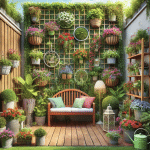Tiny Garden, Big Impact: Transforming Pocket-Sized Spaces into Lush Retreats
Welcome to the world of tiny gardens, where small spaces pack a big punch! In this guide, we'll explore how you can transform your pocket-sized outdoor areas into lush retreats that burst with life and charm. Whether you have a balcony, a small patio, or even just a tiny corner in your backyard, there's immense potential to create a green oasis that rejuvenates your senses and soothes your soul.
Urban living often comes with limited outdoor space, but that doesn't mean you have to sacrifice the joy of gardening. With some creativity, strategic planning, and a dash of inspiration, you can turn even the tiniest of areas into a vibrant paradise. So, let's dive in and discover how to make a big impact with your small garden!
Maximizing Space with Vertical Gardening
When it comes to tiny gardens, one of the most effective strategies is to think vertically. Vertical gardening allows you to make the most of limited space by utilizing walls, fences, and other vertical surfaces as growing areas. By going vertical, you can expand your garden upwards, adding layers of greenery that not only beautify your space but also maximize your planting area.
Imagine lush cascades of trailing vines, colorful flowering plants climbing trellises, and aromatic herbs growing in tiered planters. Vertical gardening opens up a world of possibilities, turning bare walls into living, breathing works of art. Whether you're growing vegetables, herbs, flowers, or a combination of all three, vertical gardening can help you achieve a thriving garden in even the smallest of spaces.
But how do you get started with vertical gardening? Fear not!
Creating a Lush Oasis in Small Spaces
Transforming your pocket-sized outdoor area into a lush retreat is within reach, no matter how limited your space may be. By employing clever design techniques, maximizing vertical space, and selecting the right plants, you can create a garden that delights the senses and provides a peaceful sanctuary right outside your door.
Remember, gardening in small spaces is not about limitations; it's about possibilities. Embrace the challenge and let your creativity flourish. With a bit of ingenuity and a touch of green-thumb magic, you can turn even the tiniest of gardens into a thriving oasis that brings joy and tranquility to your life. 
So, roll up your sleeves, grab your gardening gloves, and let's get started on transforming your tiny garden into a vibrant, inviting space that you'll love to spend time in.
And by the way: if you’re looking to enhance your gardening skills, especially in limited spaces, We at Limited Space Green Thumb offer a free report about Gardening in Limited Spaces. We also offer an online course on small space gardening techniques. Check them out.
Frequently Asked Questions:
What are some design ideas for maximizing space in a tiny garden?
Answer: To maximize space in a tiny garden, consider vertical gardening with trellises and wall planters, use container gardening to keep plants organized, and create multi-functional areas with seating that incorporates storage. Incorporate mirrors to create the illusion of more space and use a variety of plant heights to add depth and interest.
How can I create a lush look in a small garden?
Answer: Creating a lush look in a small garden can be achieved by using a variety of plants with different textures and colors, incorporating vertical elements like climbers and hanging plants, and ensuring that the garden is well-maintained. Using layers of plants, from ground cover to taller shrubs, can add depth and richness to the space. Additionally, adding features like water elements or garden art can enhance the lush feel.
What types of plants are best suited for small gardens?
Answer: The best plants for small gardens include compact and dwarf varieties that do not require a lot of space. Herbs, small flowering plants, succulents, and vertical climbers are excellent choices. Consider plants like basil, mint, petunias, and ivy, which can thrive in limited spaces. Using container-friendly plants allows for easy rearrangement and maximizes the use of available space.
